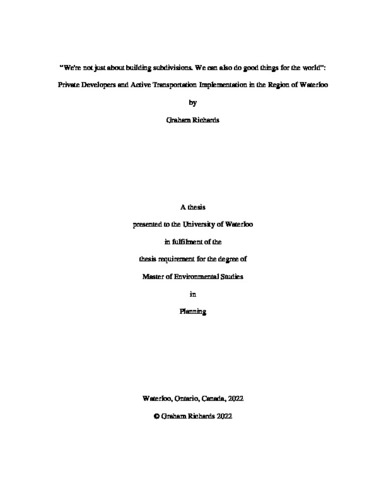| dc.contributor.author | Richards, Graham | |
| dc.date.accessioned | 2022-12-07 17:17:29 (GMT) | |
| dc.date.available | 2022-12-07 17:17:29 (GMT) | |
| dc.date.issued | 2022-12-07 | |
| dc.date.submitted | 2022-11-21 | |
| dc.identifier.uri | http://hdl.handle.net/10012/18945 | |
| dc.description.abstract | Since the mid-19th century, Canada’s population has become more urbanized as Canadians choose to live in one of its major urban centres, such as the Region of Waterloo. As this trend continues into the 21st century, increased demands have been placed on urban transportation infrastructure and services. Development patterns in Canadian cities have been predominately car-oriented creating negative health impacts for citizens and hindering climate action goals. Active transportation, such as walking and bicycling, has been promoted as a way to improve public health and reduce greenhouse gas emissions. Support for active transportation planning exists in current provincial, regional, and local planning policies. Private developers are an important part of transforming these policies into the built environment. However, previous research has shown that translating policies to practice has encountered barriers including processes that have not evolved to meet demands. Additionally, the role of private developers in implementing active transportation policies and collaboration methods between the public and private sectors remains a gap in current research. The purpose of this study was to explore the role private developers play in achieving the goals of the Region of Waterloo’s active transportation plans. An explanatory qualitative study design was chosen to explore the current planning framework and gather information through the use of document analysis and 17 key informant interviews from both the public and private sectors. The results show that there are four main barriers for private developers in achieving active transportation goals: excessive vehicle parking requirements, the lack of measures of success, the integration of active transportation initiatives into policy, and the limited methods of collaboration between the public and private sectors. This study presents recommendations to reduce or remove these barriers that can be applied by the Region of Waterloo and/or private developers to facilitate improved implementation of active transportation plans. Although focused on the Region of Waterloo, this research can be applied by planners in other Ontario municipalities to improve active transportation networks and contributes to the body of knowledge on the relationship between the public and private sectors in planning. | en |
| dc.language.iso | en | en |
| dc.publisher | University of Waterloo | en |
| dc.subject | planning | en |
| dc.subject | private developers | en |
| dc.subject | active transportation | en |
| dc.subject | Region of Waterloo | en |
| dc.title | “We're not just about building subdivisions. We can also do good things for the world”: Private Developers and Active Transportation Implementation in the Region of Waterloo | en |
| dc.type | Master Thesis | en |
| dc.pending | false | |
| uws-etd.degree.department | School of Planning | en |
| uws-etd.degree.discipline | Planning | en |
| uws-etd.degree.grantor | University of Waterloo | en |
| uws-etd.degree | Master of Environmental Studies | en |
| uws-etd.embargo.terms | 0 | en |
| uws.contributor.advisor | Dean, Jennifer | |
| uws.contributor.affiliation1 | Faculty of Arts | en |
| uws.published.city | Waterloo | en |
| uws.published.country | Canada | en |
| uws.published.province | Ontario | en |
| uws.typeOfResource | Text | en |
| uws.peerReviewStatus | Unreviewed | en |
| uws.scholarLevel | Graduate | en |

